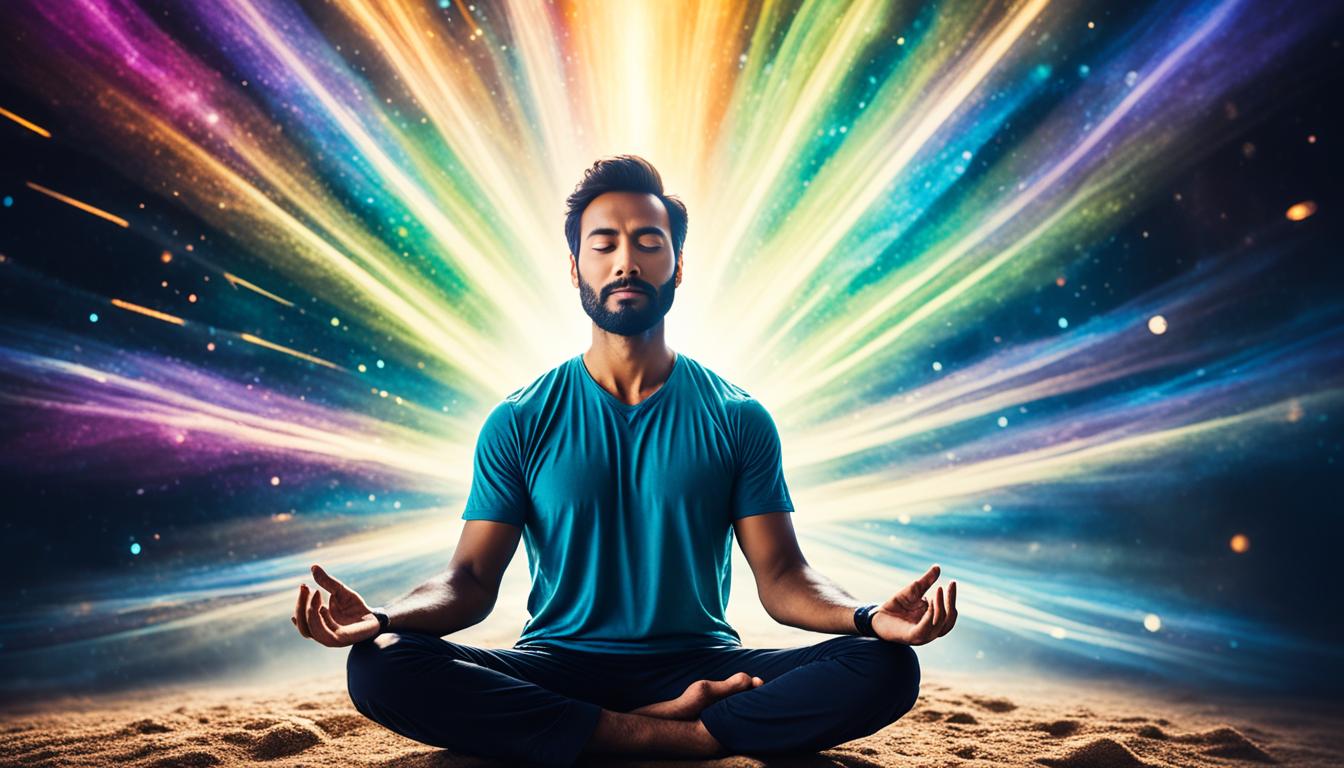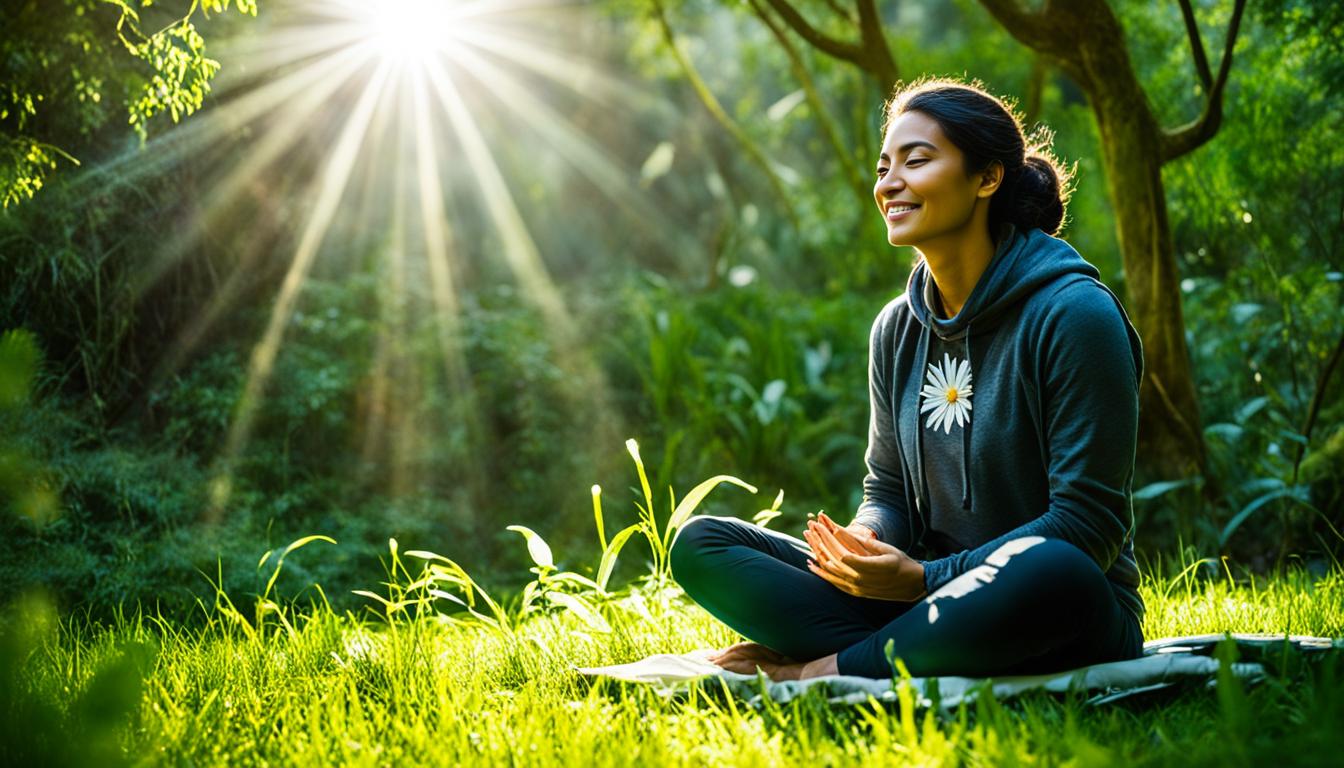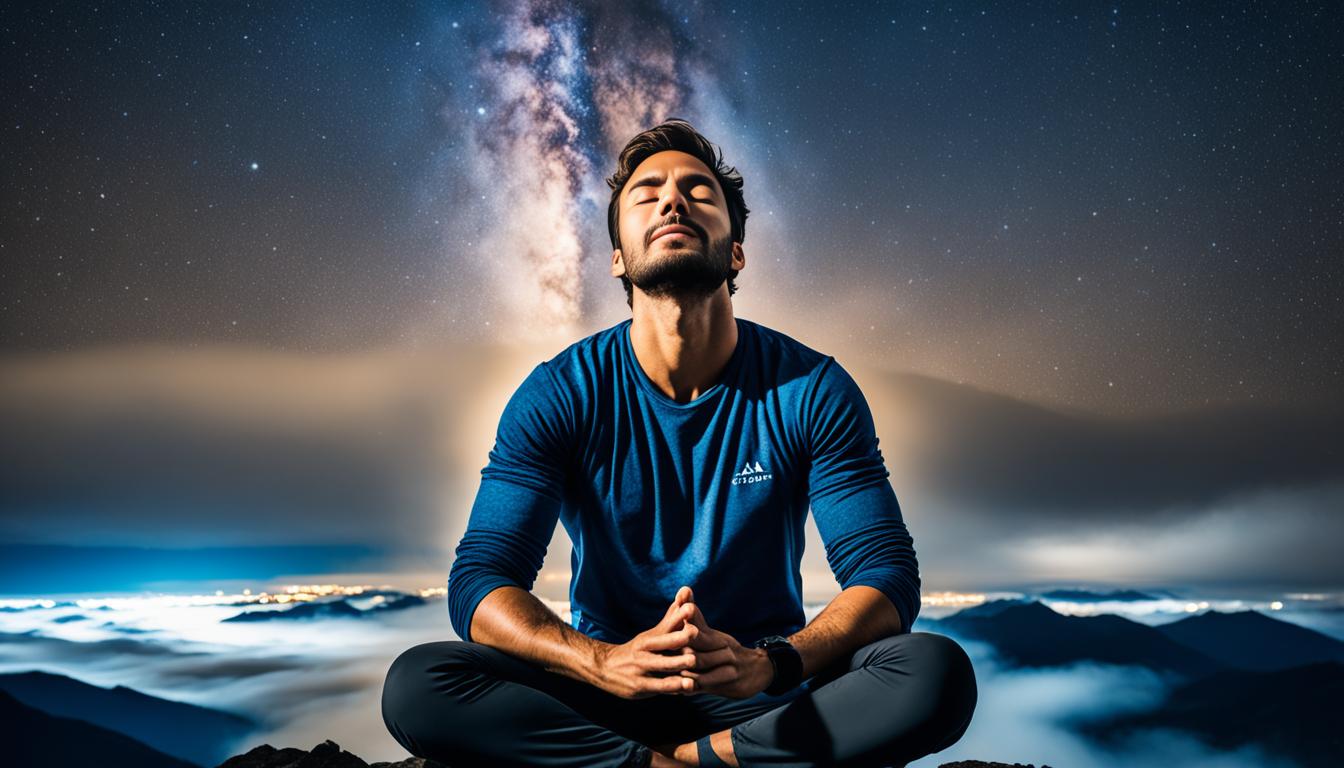Disclosure: This Post Contains Affiliate Links; We earn a commission on purchases.
Welcome to a journey of inner exploration and self-discovery through the practice of meditation. In this article, we will delve into the profound benefits of meditation for personal growth and self-awareness. Whether you are new to meditation or a seasoned practitioner, this exploration will provide valuable insights and tools to enhance your mindfulness journey.
Meditation has been practiced for centuries, with the aim of connecting with our true selves and exploring the depths of our consciousness. Through dedicated practice, we can peel back the layers of stress, distractions, and external influences, enabling us to tap into our inner wisdom and find a sense of peace, clarity, and purpose.
With mindfulness as our guide, we will navigate through the different aspects of meditation, from its origins and traditions to the psychological and physiological benefits it offers. We will uncover the techniques that can propel us to deeper levels of consciousness and explore practical ways to incorporate meditation into our daily lives.
In addition, we will review the book “The Space Within” by Greg O’Connor and Josh Fagin, delving into its powerful insights on mindfulness, consciousness, and the transformative potential of self-awareness. This review will serve as a source of inspiration and further deepen our understanding of the profound connection between mindfulness and inner exploration.
Throughout this exploration, we will examine the integration of mindfulness and consciousness from psychological and Ayurvedic perspectives, understanding how establishing balance between these two aspects can enhance our overall well-being. We will also explore the consequences of an imbalance and provide practical guidance on finding equilibrium.
Are you ready to embark on this transformative journey of inner exploration through meditation? Join us as we uncover the path to self-discovery, personal growth, and a deeper sense of self-awareness.
Key Takeaways:
- Meditation is a powerful tool for inner exploration and self-discovery.
- Regular meditation practice can enhance personal growth and self-awareness.
- The origins of meditation trace back to ancient traditions and spiritual practices.
- There are various meditation techniques that can be utilized for deeper levels of consciousness.
- Finding balance between mindfulness and consciousness is essential for overall well-being.
The Origins and Traditions of Meditation
Meditation has a rich history that dates back to ancient times. Its origins can be traced back to the Vedic traditions of ancient India, where it was practiced as a spiritual discipline. These early teachings emphasized the importance of stilling the mind and turning inward to discover one’s true nature. The ancient Indian texts known as the Vedas contain references to meditation techniques that were used for self-realization and achieving higher states of consciousness.
As meditation spread beyond India, it found its way into various spiritual and religious traditions across the world. One notable tradition that incorporated meditation is Zen Buddhism. Originating in China and later flourishing in Japan, Zen Buddhism emphasizes the practice of meditation as a means to achieve enlightenment and awaken to the nature of reality. Zen meditation, also known as Zazen, focuses on seated meditation and mindfulness in everyday activities.
Another influential tradition is mindfulness meditation, which has its roots in Buddhist teachings. Mindfulness meditation involves cultivating a non-judgmental awareness of the present moment. It has gained popularity in recent years due to its effectiveness in reducing stress and promoting well-being. This practice has been adapted and integrated into various secular contexts, such as healthcare, psychology, and education.
Different meditation techniques have emerged from these traditions, each with its own unique approach and purpose. Mantra meditation, for example, involves the repetition of a sacred word or phrase to focus the mind and attain a deep state of concentration. Visualization meditation uses mental imagery to create a specific experience or outcome. Other techniques focus on breath awareness, body scanning, or cultivating loving-kindness towards oneself and others.
“The goal of meditation is not to control your thoughts, but to stop letting them control you.” – Unknown
A Comparison of Meditation Techniques
| Technique | Description |
|---|---|
| Mantra meditation | Involves the repetition of a sacred word or phrase to focus the mind and attain a deep state of concentration. |
| Zen meditation (Zazen) | Focuses on seated meditation and mindfulness in everyday activities, with an emphasis on posture and breath. |
| Mindfulness meditation | Involves cultivating a non-judgmental awareness of the present moment, often through the focus on breath or body sensations. |
| Visualization meditation | Uses mental imagery to create a specific experience or outcome, such as picturing a peaceful scene or envisioning success. |
| Loving-kindness meditation | Focuses on developing feelings of love, compassion, and well-wishing towards oneself and others. |
The Psychological and Physiological Benefits of Meditation
Scientific research has unearthed numerous benefits of regular meditation practice, both for our psychological well-being and our physical health. Let’s explore some of the remarkable advantages that meditation offers.
Stress Reduction
Meditation has proven to be a potent tool for reducing stress levels. By actively engaging in mindful meditation, individuals can effectively manage the pressures and demands of everyday life. Studies have shown that meditation promotes the release of endorphins, the body’s natural feel-good hormones, which help alleviate stress and induce a state of calm and relaxation.
Anxiety Relief
Many individuals experience anxiety in various forms, be it generalized anxiety disorder or specific anxiety related to social situations or phobias. Meditation has been found to be an effective strategy for alleviating anxiety symptoms. By practicing mindfulness and focused breathing, individuals can cultivate a sense of inner peace, reduce anxiety, and develop a greater sense of emotional resilience.
Improved Cognitive Abilities
Meditation has been found to enhance cognitive abilities, including attention span, concentration, and memory. Regular meditation practice stimulates the prefrontal cortex, the part of the brain responsible for executive functions, leading to improved cognitive performance. This heightened mental clarity and focus allow individuals to approach tasks with greater efficiency and productivity.
Enhanced Empathy
Empathy is the ability to understand and share the feelings of others, promoting connection and compassion. Meditation has been shown to enhance empathy, cultivating a deeper sense of understanding and kindness towards others. Through meditation, individuals develop a greater capacity to be present, listen attentively, and respond empathetically, strengthening interpersonal relationships and fostering harmony in social interactions.
Incorporating mindfulness meditation into your daily routine can bring about a myriad of psychological and physiological benefits. The next section will guide you on how to get started with meditation, creating a foundation for inner exploration and personal growth.
Getting Started with Meditation
Are you ready to start your meditation journey? Here are some practical tips to help you get started on your path to inner peace and mindfulness.
Create a Dedicated Meditation Space
Find a quiet and comfortable space in your home where you can practice meditation without distractions. It could be a spare room, a corner of your bedroom, or even a cozy spot in your living room. Make sure the space is clean and clutter-free, creating a calming atmosphere that promotes relaxation and focus.
Find the Right Posture
The right posture is crucial for a successful meditation practice. Sit on a cushion or a chair with your back straight, shoulders relaxed, and feet flat on the floor. Maintain a comfortable yet alert position, allowing your breath to flow freely. If sitting cross-legged is uncomfortable, you can try sitting on a chair or using additional bolsters and cushions to support your body.
Cultivate the Right Mindset
Set your intention and cultivate a positive mindset before each meditation session. Approach your practice with curiosity, openness, and non-judgment. Let go of any expectations or self-criticism and embrace each moment as it unfolds. Remember that meditation is a journey, and every session is an opportunity for growth and self-discovery.
Guided or Unguided Meditation?
There are different approaches to meditation, including guided and unguided practices. Guided meditation involves following along with a meditation teacher or a prerecorded audio that provides instructions and visualizations. This can be beneficial, especially for beginners who may find it challenging to meditate in silence. On the other hand, unguided meditation allows you to practice in silence, focusing solely on your breath or a mantra of your choice. Both approaches have their benefits, so choose the one that resonates with you and fits your needs.
“Meditation is not a means to an end. It is both the means and the end.”
Advanced Meditation Techniques
Once you have established a regular meditation practice and experienced the benefits of mindfulness, you may find yourself seeking more profound experiences and deeper levels of consciousness. This is where advanced meditation techniques come into play. These techniques can help you tap into the limitless potential of your mind and explore the boundless realms of awareness.
One powerful technique in advanced meditation is the use of mantras. Mantras are sacred sounds or words that are repeated during meditation to focus the mind and evoke a specific state of being. By chanting a mantra, you can create a harmonizing resonance within your body and mind, allowing you to access deeper states of consciousness. Some popular mantras include “Om,” “So Hum,” and “Om Shanti.”
“The repetition of a sacred word or phrase, or mantra, is one of the most effective techniques for exploring the deeper levels of consciousness. As you repeat the mantra, your mind becomes focused and calm, and you can transcend the ordinary thinking mind to access higher realms of awareness.”
Another technique that can take your meditation practice to new heights is visualization. With visualization, you create vivid mental images in your mind’s eye to connect with specific intentions or desired outcomes. By immersing yourself in these visualizations, you can not only deepen your concentration but also tap into the power of your imagination to manifest positive changes in your life.
Concentration techniques are also essential in advanced meditation. These techniques involve focusing your attention on a single point or object, such as your breath, a candle flame, or a specific sensation in your body. By honing your concentration skills, you can train your mind to stay focused for longer periods and enter heightened states of awareness.
Advanced meditation techniques can take your practice to the next level, opening doors to profound experiences and profound self-discovery. Whether you choose to incorporate mantras, visualization, or concentration techniques into your practice, remember that consistency and intention are key. As you explore these techniques, you may find that your perception of reality expands, and your connection to the infinite becomes stronger.
The Space Within: A Book Review
In this section, we will provide a review of the book “The Space Within” by Greg O’Connor and Josh Fagin. This thought-provoking book explores the concepts of mindfulness, consciousness, and the transformative power of self-awareness. The authors offer unique perspectives and insights that will inspire readers to delve deeper into their own inner journey.
| Book Title | Authors | Themes Explored |
|---|---|---|
| The Space Within | Greg O’Connor and Josh Fagin | Mindfulness, Consciousness, Self-awareness |
The Space Within takes readers on a captivating exploration of the mind and its potential for transformation. Through engaging stories, scientific research, and practical exercises, O’Connor and Fagin guide readers on a journey towards a deeper understanding of themselves and their connection to the world around them.
One of the key themes explored in the book is mindfulness. The authors highlight the importance of cultivating present-moment awareness as a foundation for personal growth and well-being. They offer insightful practices and techniques to develop mindfulness, allowing readers to tap into their inner wisdom and live more consciously.
Consciousness is another central theme in the book. O’Connor and Fagin delve into the nature of consciousness and its profound impact on our lives. They explore how expanding our consciousness can lead to a greater sense of interconnectedness, compassion, and joy.
The Space Within is a comprehensive guide that seamlessly combines scientific research, spiritual teachings, and personal anecdotes. It offers readers a practical roadmap for self-discovery and personal transformation. Whether you are new to mindfulness and consciousness or have been on this path for a while, this book will deepen your understanding and inspire you to explore the space within.

“The Space Within” is a must-read for anyone seeking to cultivate mindfulness, expand their consciousness, and unlock the power of self-awareness. The authors’ profound insights and practical guidance will guide readers towards a more meaningful and fulfilling existence.
The Integration of Mindfulness and Consciousness
In the journey of inner exploration, the integration of mindfulness and consciousness plays a crucial role. From both a psychological and Ayurvedic perspective, these two concepts are deeply interconnected and can greatly contribute to overall well-being.
The Psychological Perspective
In psychology, mindfulness is described as a state of active awareness in the present moment, without judgment or attachment. It involves paying attention to thoughts, emotions, and sensations, fostering a deep sense of self-awareness.
“Mindfulness is the key to unlock the full potential of consciousness. By cultivating mindfulness, we can tap into the depths of our consciousness and gain profound insights into ourselves and the world around us.” – Dr. Michael Green, psychologist and mindfulness expert
Practicing mindfulness enables individuals to observe their thoughts and emotions from a non-reactive standpoint. This heightened awareness enhances consciousness, allowing individuals to gain a deeper understanding of themselves and their experiences.
The Ayurvedic Perspective
Ayurveda, the ancient Indian system of medicine, views mindfulness and consciousness as integral components of holistic well-being. According to Ayurveda, an optimal state of well-being arises when there is a harmonious balance between these two aspects.
“In Ayurveda, the balance of mindfulness and consciousness is considered essential for maintaining physical, mental, and spiritual health. When these two elements are in equilibrium, individuals experience a sense of wholeness and balance in their lives.” – Dr. Aparna Sharma, Ayurvedic practitioner
Ayurvedic practices, such as meditation, yoga, and mindful eating, are designed to cultivate mindfulness and foster a deep connection with consciousness. These practices aim to bring the mind and body into a state of balance, promoting overall well-being.
Integrating Mindfulness and Consciousness
To integrate mindfulness and consciousness into daily life, it is essential to cultivate mindfulness through various practices. Engaging in regular meditation, practicing mindful breathing exercises, and maintaining present-moment awareness are effective ways to enhance mindfulness.
Here are some practical tips to integrate mindfulness and consciousness:
- Set aside dedicated time for meditation or mindfulness practices.
- Incorporate mindful eating by savoring each bite and paying attention to the flavors and textures of your food.
- Practice gratitude and cultivate awareness of the present moment throughout the day.
- Engage in activities that bring joy and deepen your connection with consciousness, such as nature walks, creative expression, or journaling.
By embracing mindfulness and consciousness in your daily life, you can cultivate a sense of balance, harmony, and overall well-being.
Implications of Mindfulness and Consciousness Imbalance
When it comes to our mental and physical well-being, finding a balance between mindfulness and consciousness is crucial. Mindfulness, the practice of being fully present and aware in the present moment, and consciousness, our awareness of our thoughts, feelings, and experiences, play integral roles in our overall health. However, an imbalance between the two can have significant implications for our well-being.
A lack of mindfulness or a distorted consciousness can contribute to a range of health issues, including chronic stress, anxiety, and depression. When we are not mindful, our minds tend to wander, dwelling on the past or worrying about the future. This constant mental unrest can lead to stress-related disorders, strain on our relationships, and a decline in our overall quality of life.
On the other hand, an imbalance in consciousness, such as being overly absorbed in our thoughts or detached from our emotions, can also have negative consequences. It can result in emotional turmoil, as we may find it challenging to connect with and regulate our feelings. This imbalance can manifest as mental unrest, a sense of disconnection, and even physical symptoms such as tension headaches or digestive issues.
Achieving a balance between mindfulness and consciousness is essential for optimal well-being. When we are mindful, we cultivate a state of present-centered awareness, allowing us to better manage stress, engage more fully in our relationships, and make choices aligned with our values. When our consciousness is in balance, we develop a deeper understanding of ourselves, regulating our emotions and maintaining a sense of overall stability.
By integrating mindfulness practices into our daily lives, such as meditation and mindful breathing exercises, we can enhance our ability to stay present and cultivate a healthy level of consciousness. Mindfulness and consciousness work hand in hand, supporting each other in creating a harmonious state of being.
When mindfulness is in balance and consciousness is clear, we experience a sense of peace, harmony, and well-being.
It is important to recognize the signs of mindfulness and consciousness imbalance and take proactive steps to restore balance. Engaging in self-reflection, seeking support from professionals or mindfulness communities, and adopting a holistic approach to well-being can all contribute to finding equilibrium.
The Importance of Seeking Balance
Without balance between mindfulness and consciousness, our mental and physical health may suffer. Let us explore the practical implications of this imbalance:
| Implications of Mindfulness and Consciousness Imbalance | Effects on Health |
|---|---|
| Lack of mindfulness | Chronic stress, anxiety disorders, reduced immune function, sleep disturbances |
| Distorted consciousness | Emotional instability, difficulty regulating emotions, strained relationships, physical symptoms (headaches, digestive issues) |
As the table demonstrates, mindfulness and consciousness imbalance can have far-reaching effects on our health, both physically and mentally. It is in our best interest to strive for balance, creating a foundation for optimal well-being and personal growth.
Finding Balance: The Path to Well-being
Finding balance between mindfulness and consciousness is key to achieving overall well-being. By incorporating mindfulness practices, meditation, proper nutrition, and making mindful lifestyle choices, individuals can cultivate a state of equilibrium that promotes mental and physical well-being.
Mindfulness practices such as meditation, yoga, and deep breathing exercises can help us develop self-awareness, focus, and reduce stress. These practices allow us to connect with the present moment, quiet the mind, and cultivate a sense of inner peace.
Regular meditation is a powerful tool for achieving balance and enhancing well-being. It allows us to calm our thoughts, gain clarity, and tap into our inner wisdom. Taking a few minutes each day to practice meditation can have a profound impact on our overall well-being.
Nutrition plays a vital role in maintaining balance and promoting well-being. Choosing nourishing foods rich in vitamins, minerals, and antioxidants fuels our bodies and supports optimal physical and mental health. By making mindful choices about what we eat, we can nourish our bodies and minds, leading to improved energy levels and overall well-being.
Our lifestyle choices also impact our well-being. Engaging in activities that bring us joy, spending time outdoors, and practicing self-care contribute to a balanced and fulfilling life. It’s essential to prioritize self-care and find activities that promote relaxation, creativity, and connection.
“Balance is not something you find, it’s something you create” – Jana Kingsford
By creating a harmonious balance between mindfulness practices, meditation, nutrition, and lifestyle choices, individuals can enhance their overall well-being. It’s important to remember that finding balance is a journey, and it requires consistency, self-reflection, and adaptability.

The Power of Mindfulness and Consciousness: A Call to Action
Mindfulness and consciousness have the potential to bring about positive change and personal transformation in our lives. By embracing these concepts, we can tap into a deeper sense of interconnectedness and create a more meaningful and fulfilling existence.
When we practice mindfulness, we cultivate a heightened awareness of the present moment, allowing us to fully engage with our thoughts, emotions, and experiences. This increased self-awareness enables us to make conscious choices and respond to life’s challenges with clarity and compassion.
Consciousness, on the other hand, extends beyond our individual experiences and connects us to the larger web of life. It is the recognition of our interconnectedness with other beings and the world around us. When we cultivate consciousness, we develop a sense of responsibility for the well-being of others and the planet.
Combining mindfulness and consciousness creates a powerful synergy that can lead to personal transformation. As we become more mindful, we start to notice patterns of thought and behavior that no longer serve us. We gain the ability to observe these patterns without judgment and make conscious choices to change them.
“The power of mindfulness and consciousness lies in their ability to awaken us to our true potential and guide us towards positive change.”
This journey of personal transformation is not always easy, but it is immensely rewarding. It allows us to break free from limiting beliefs, release attachments, and discover a deeper sense of purpose. By integrating mindfulness and consciousness into our daily lives, we can unlock our inner wisdom and create a ripple effect of positive change in the world.
Now is the time to take action. Start by incorporating mindfulness practices into your daily routine, such as meditation, breath awareness, or mindful movement. These practices will help you develop a stronger connection to your inner self and cultivate a greater sense of inner peace.
Additionally, take moments throughout your day to pause and bring awareness to your thoughts, emotions, and actions. This simple act of mindfulness can have a profound impact on how you navigate through life and interact with others.
Remember, personal transformation and positive change extend beyond the individual. By cultivating mindfulness and consciousness, we can become catalysts for global transformation. Our actions, no matter how small, have the power to create a ripple effect that spreads throughout our communities and beyond.
Let us embrace the power of mindfulness and consciousness and be the change we wish to see in the world.
| Mindfulness and Consciousness | Benefits |
|---|---|
| Awareness of the present moment | Improved focus and attention |
| Increased self-awareness | Enhanced emotional well-being |
| Recognition of interconnectedness | Greater empathy and compassion |
| Ability to make conscious choices | Reduced stress and anxiety |
| Personal transformation | Positive change in relationships and society |
Conclusion
In conclusion, the journey of inner exploration through meditation is a powerful tool for self-discovery and personal growth. By cultivating mindfulness and consciousness, individuals can embark on a transformative path towards greater self-awareness and well-being.
Throughout this article, we have explored the origins and traditions of meditation, as well as its psychological and physiological benefits. We have provided practical tips for getting started with meditation and discussed advanced techniques for accessing deeper levels of consciousness.
Furthermore, we reviewed the book “The Space Within” by Greg O’Connor and Josh Fagin, which offers valuable insights into mindfulness, consciousness, and the transformative power of self-awareness. From integrating mindfulness and consciousness to understanding the implications of imbalance, we have delved into the practical applications of these concepts in daily life.
As we conclude, we encourage readers to continue their inner exploration through meditation and mindfulness. By embracing these practices, individuals can unlock their full potential, experience personal transformation, and cultivate a deeper sense of interconnectedness with themselves and the world around them. The journey of self-discovery begins with mindfulness and consciousness leading the way.
Source Links
- https://www.graygroupintl.com/blog/meditation
- https://medium.com/@funk.jonah/exploring-the-space-within-a-deep-dive-into-the-human-mind-and-connection-26ec2f884ea3
- https://www.linkedin.com/pulse/exploring-mindfulness-consciousness-deep-dive-ayurvedic-mack
Ryan Conlon is a passionate advocate for mindfulness and meditation, dedicated to helping others discover the transformative power of these practices in their lives. As the founder of Daily Meditation, Ryan’s mission is to provide a sanctuary for individuals seeking peace, clarity, and well-being amidst the chaos of modern life. With a background in psychology and years of personal experience with meditation, Ryan brings a wealth of knowledge and insight to his work. Through Daily Meditation, he shares practical guidance, inspirational content, and expert resources to support others on their journey toward greater mindfulness, resilience, and inner peace.
Subscribe to Our Newsletter

















